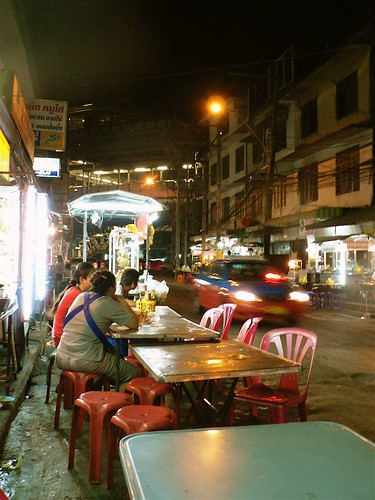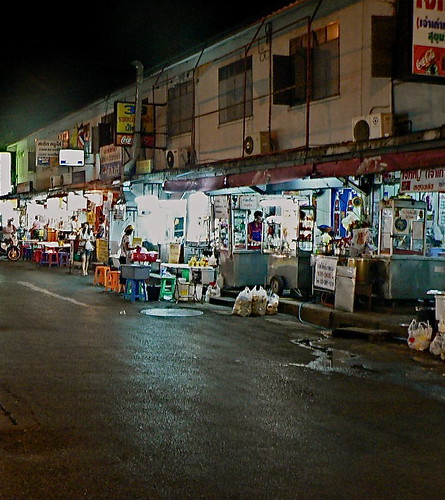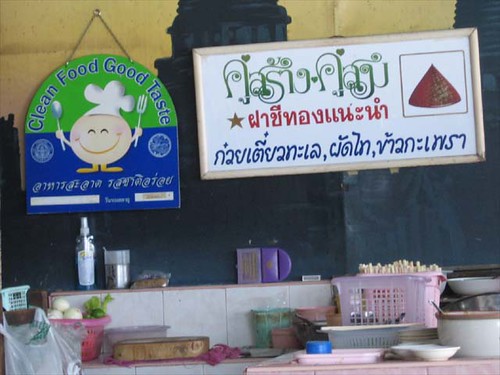Supermarket Power and the Evasive Mysteries of the Bangkok's Hawker Stalls
Wednesday, 13 August 2008 by Dr Maytel
Since doing my fieldwork back in 2005-2006, I have ever more mused on the idea that many people, academics included, over estimate the dominance of modern food and supermarkets. This is of course subject to much debate and could be the topic of the PhD thesis in itself.
That's what excited me about meeting Nalika at a PhD conference a couple years back on agrarian change. I had read her PhD proposal, which was aimed at studying such change, through consumption patterns in Thailand. Most people tend to study such change from the production end, not the consumption end. Although she has since changed her research topic, we obviously both maintain a special interest in the subject of food consumption.
What I specifically liked about Nalika's proposal is that it challenged the assumption that the world of food contains two diametrically opposed organisational forms in terms of food marketing: large global food chains dominated by multinationals and small farmers and/ or food artisans struggling to survive and on the forefront of traditional/alternative food networks. Instead it recognised that Thai people, like so many of us source food from a variety of places including supermarkets, local stalls, fresh markets, 7 elevens, friends gardens (except apparently those living in "food desserts" a terrifically horrifying thought indeed). This idea was reinforced to me later in a book I read when the author noted that many of these debates over economy and trade are necessarily misleading for the sake of argument. The author emphasised how except for on the very margins of human existence do people only source their goods and services from one place only. Extreme autarky and/or food desserts are the outlying ends of most people's consumption experience. There is multiplicity in most economies as their are in most people's daily consumption.
But from my own perspective and surroundings in the urban hub of a middle income newly industrialising country, the idea that there are only small local farmers/ artisans vs large multinational food giants, to a large extent misses the middle. A lot of people who live and toil in Bangkok, both rich and poor buy, eat and source their daily food at hawkers stalls.

Tasty, spicy bowls of noodles, are decent, healthy, and cheap and is what feeds the urban masses. There's also grilled fish, meat sticks, salads, coffee hawkers, fresh fruit hawkers and even road side bars for variety. Produce from these stalls appears to be sourced from a range of places, including wet markets and supermarkets. A common assumption by many a falang is that these stalls are run solely by the people who man them, as some sort of extension of their home economy...some are in fact run as a sideline family business out of the front of homes or as an additional money maker. But if you've ever tried to make a bowl of noodles at home, you soon realise that its a lot of effort for a solitary bowl
I made pho bo the other day, 24 hour long process of making the stock, brining it to the boil, tipping off the first boil, then boiling again with spices over 24 hours to get the flavour. Making these noodles, I fast realised that noodles are one of those dishes that is pre-disposed to large scale production, maybe not industrial because there is a point at which I'm sure noodle production gets too large and looses flavour but at least medium to large. Plus at the price point that exists here in Bangkok, 25 baht per bowl, you need to sell a lot of noodles for it to make sense as a business proposition.
Recently, Hock noticed one of our local noodle stalls setting up for the day. A large brand new pick up truck drove up to their spot and delivered the ingredients for the day. This particular stall sells kanom jeen. They then drove on to do more deliveries to other stalls. It seems certain that this operator has several road side branches, operating on a fairly large scale. The stand is open from early in the morning to late at night and there appears to be shift workers.

Franchised noodle branches in Thailand appear to have reached its greatest heights in "chai see" (four men). Four Men noodle stands are ubiquitous in and outside of Bangkok. They are everywhere announced by a big yellow sign, bowl of noodles with a number 4 above them. These are not the best noodles but as Aong said, "if you're hungry, you'll eat them"
The tendency towards franchises and branches has of course counter resistance. Many restaurants now declare "mai mee sakha", "don't have any branches". An announcement made with pride that is meant to inspire loyalty and acceptance of slightly higher prices. Where once the Thai government's "good clean food" sign signalled that the stall wouldn't make you sick, the current new wave of food convention appears to be self-regulated, not government regulated and elicits market competitiveness through conflating small scale production with quality and care. Which, when you think about it is the opposite of previous government perceptions of smaller vendors that inspired the "clean food" seal of government approval in the first place.

Source
I'm yet to understand the dynamics of the hawker economy fully. On Sukhumvit Soi 11, which is close to my house I notice that hawkers change rather frequently, or they change their carts. Recent construction on the street has seen a lot more Isaan food turn up, to cater to the mainly Isaan construction workers. Some carts are manned by the same hawkers who seem to be able to swap carts around from noodles, to grilled meat with great ease. Most carts are overseen by the soi police. Most soi's have their own local patrols, aside from extracting bribes, I'm not sure exactly what their role is, but Hock seems to think that Masta Grilla moved on due to police harassment.
Master grilla seems to have moved on indefinitely and so has my mushroom soup guy only to be replaced by mushroom soup lady who moves between soi 11 and 19. Mushroom soup appears to be a new addition to the hawker stands. There was a great chicken noodle soup on the street a while back but the lady swapped to sweetened coffee. Maybe I'm reading too much into it but I like to see the hawker stalls near my street as a sort of signifier of the dynamic changes taking place in Bangkok.
With all this flexibility at hand, the ability to change carts according to the ever shifting migrant population, changing tastes and food preferences, whilst remaining cheap and accessible and also able to take advantage of economies of scale, it will be from, my understanding, a long time before Thailand sees the cannibalisation of its hawker markets by large multinationals, supermarkets and fast food outlets. For now they appear to co-exist quite well.
That's what excited me about meeting Nalika at a PhD conference a couple years back on agrarian change. I had read her PhD proposal, which was aimed at studying such change, through consumption patterns in Thailand. Most people tend to study such change from the production end, not the consumption end. Although she has since changed her research topic, we obviously both maintain a special interest in the subject of food consumption.
What I specifically liked about Nalika's proposal is that it challenged the assumption that the world of food contains two diametrically opposed organisational forms in terms of food marketing: large global food chains dominated by multinationals and small farmers and/ or food artisans struggling to survive and on the forefront of traditional/alternative food networks. Instead it recognised that Thai people, like so many of us source food from a variety of places including supermarkets, local stalls, fresh markets, 7 elevens, friends gardens (except apparently those living in "food desserts" a terrifically horrifying thought indeed). This idea was reinforced to me later in a book I read when the author noted that many of these debates over economy and trade are necessarily misleading for the sake of argument. The author emphasised how except for on the very margins of human existence do people only source their goods and services from one place only. Extreme autarky and/or food desserts are the outlying ends of most people's consumption experience. There is multiplicity in most economies as their are in most people's daily consumption.
But from my own perspective and surroundings in the urban hub of a middle income newly industrialising country, the idea that there are only small local farmers/ artisans vs large multinational food giants, to a large extent misses the middle. A lot of people who live and toil in Bangkok, both rich and poor buy, eat and source their daily food at hawkers stalls.

Tasty, spicy bowls of noodles, are decent, healthy, and cheap and is what feeds the urban masses. There's also grilled fish, meat sticks, salads, coffee hawkers, fresh fruit hawkers and even road side bars for variety. Produce from these stalls appears to be sourced from a range of places, including wet markets and supermarkets. A common assumption by many a falang is that these stalls are run solely by the people who man them, as some sort of extension of their home economy...some are in fact run as a sideline family business out of the front of homes or as an additional money maker. But if you've ever tried to make a bowl of noodles at home, you soon realise that its a lot of effort for a solitary bowl
I made pho bo the other day, 24 hour long process of making the stock, brining it to the boil, tipping off the first boil, then boiling again with spices over 24 hours to get the flavour. Making these noodles, I fast realised that noodles are one of those dishes that is pre-disposed to large scale production, maybe not industrial because there is a point at which I'm sure noodle production gets too large and looses flavour but at least medium to large. Plus at the price point that exists here in Bangkok, 25 baht per bowl, you need to sell a lot of noodles for it to make sense as a business proposition.
Recently, Hock noticed one of our local noodle stalls setting up for the day. A large brand new pick up truck drove up to their spot and delivered the ingredients for the day. This particular stall sells kanom jeen. They then drove on to do more deliveries to other stalls. It seems certain that this operator has several road side branches, operating on a fairly large scale. The stand is open from early in the morning to late at night and there appears to be shift workers.

Franchised noodle branches in Thailand appear to have reached its greatest heights in "chai see" (four men). Four Men noodle stands are ubiquitous in and outside of Bangkok. They are everywhere announced by a big yellow sign, bowl of noodles with a number 4 above them. These are not the best noodles but as Aong said, "if you're hungry, you'll eat them"
The tendency towards franchises and branches has of course counter resistance. Many restaurants now declare "mai mee sakha", "don't have any branches". An announcement made with pride that is meant to inspire loyalty and acceptance of slightly higher prices. Where once the Thai government's "good clean food" sign signalled that the stall wouldn't make you sick, the current new wave of food convention appears to be self-regulated, not government regulated and elicits market competitiveness through conflating small scale production with quality and care. Which, when you think about it is the opposite of previous government perceptions of smaller vendors that inspired the "clean food" seal of government approval in the first place.

Source
I'm yet to understand the dynamics of the hawker economy fully. On Sukhumvit Soi 11, which is close to my house I notice that hawkers change rather frequently, or they change their carts. Recent construction on the street has seen a lot more Isaan food turn up, to cater to the mainly Isaan construction workers. Some carts are manned by the same hawkers who seem to be able to swap carts around from noodles, to grilled meat with great ease. Most carts are overseen by the soi police. Most soi's have their own local patrols, aside from extracting bribes, I'm not sure exactly what their role is, but Hock seems to think that Masta Grilla moved on due to police harassment.
Master grilla seems to have moved on indefinitely and so has my mushroom soup guy only to be replaced by mushroom soup lady who moves between soi 11 and 19. Mushroom soup appears to be a new addition to the hawker stands. There was a great chicken noodle soup on the street a while back but the lady swapped to sweetened coffee. Maybe I'm reading too much into it but I like to see the hawker stalls near my street as a sort of signifier of the dynamic changes taking place in Bangkok.
With all this flexibility at hand, the ability to change carts according to the ever shifting migrant population, changing tastes and food preferences, whilst remaining cheap and accessible and also able to take advantage of economies of scale, it will be from, my understanding, a long time before Thailand sees the cannibalisation of its hawker markets by large multinationals, supermarkets and fast food outlets. For now they appear to co-exist quite well.

for sure, that is the interesting part.... whether consumers' choices can be dictated to.
i guess the radio host quoted in the South LA story was overstating it when he said the minutiae of what people put in their mouths was being scrutinized.
Because if an area's food vendors are 40% fast food already, it's not really going to take away their freedom to eat fast food if the government simply limits an increase.#
They'll still have 10 mcDonalds on their block to choose from!
somehow i can't see anything wrong (if an area is showing health problems or whatever) with legislating to preserve a balance, so that people retain a choice to eat at whatever food stand, supermarket or mega-chain they choose -
rather than having one food culture dominate. like the proverbial jellyfish.
obviously this is not the case everywhere -
and any attempt to regulate will always meet fierce resistance. as in Jamie Oliver's botched school dinner campaign.
i guess the problem there was that they tried to remove the choice of junk food completely. and the healthy (reportedly unappetising) lunches were also expensive to make.
it would have been better to find a more incremental approach to educating parents and providing discounts for simple healthy things like fruit,
rather than trying to change everything at once by enforcing weird pasta dishes for kids.
... i guess any american would have a very different perspective on the monopoly of multinational food corporations than someone who lives in a foodstall utopia in BKK.... or in the Antipodes for that matter.
but i think the eating habits outside of the trendier parts of Melbourne and Auckland can be similarly shocking. I remember a Japanese girl who was traumatised from a home stay in NZ where they never served a single fresh, unfrozen vegetable.
patterns of consumption due to the conveniance of prepared, frozen or fast foods can be really crazy.
i am always amused when american musicians come on tour in Europe, more often than not, the stereotypes of American 'mainstream' are confirmed in wonderful ways!
although having a few fast food outlets or other mass marketed convenience foods here and there might not be the scourge of society,
there's no doubt they can in some communities lead to increased obesity and so on.
maybe you have to see that in its extreme manifestation to feel any sense of alarm about multinational food culture hegimony and all that jazz.
yeah, a lot of people tend to comment that the same thing is happening here with the Thai's love of fast food and obesity is rising, of course america is different again and all these things tend to intersect in different ways, in different places according to the choices people make. Are people victims of fast food or poverty? I don't know. I guess these are the big questions. I guess like a typical anthropologist I like to focus more on personal agency in the face of hegemony rather than bewailing powerlessness. But the fact that people are talking about these things probably means changes and resistance are afoot as we speak
I just read the magazine food edition of the Bangkok Post that had a lot of Thai foodies decrying the loss of Thai food "authenticity". "people make tom yum goong with milk"!!!!! Heavens...as Katherine Tate would say..."the dirty inauthentic bastards"
So all this recent harping on about the death of Thai food (there was another article about it in BK magazine) probably means that "authentic" Thai is about to under go some sort of "revival"
seems like America's cultural exports play a big part in us wanting to eat hamburgers and things...
I found it bizarre the first time I went there how I knew the names of so many junk food items and conveniance stores (etc) ...oh so dear & familiar from books and movies etc
Now that I've seen a twinkie and read the ingredients there's no way I'd actually eat a twinkie .....yet the 'idea' of the twinkie from books and TV is still so strong that I would, to this day, still like to at least eat an imaginary twinkie.
woah weird the first part of the post above got deleted.
I started the USA post thing with something like:
this term 'personal agency' is nice...
i am actually a big fan of these strange cross cultural fusions and I kinda think that type of thing can be how cuisines have always evolved... like thai muslim food influenced by arabic or whatever.... same as languages, they were never 'pure'
In Japan, maybe younger people don't spend so much time making o-seiji ryouri as their mums, but the national cuisine doesn't seem to be in any danger.
so as a side note I was wondering about Thai TV programming.... are there a lot of Thai costume historical dramas, or food advertising that reinforces traditional Thai national identity?
Maybe, since we are all so impressionable and open to suggestion, there needs to be some kind of daily reminder, for us to keep making food choices that uphold ancient traditions...
some of this will be environmental.... as long as the yam seller is still making his rounds and singing the yam song, people will continue to feel nostalgic about that hot roasted yam as a part of their identity....
This comment has been removed by the author.